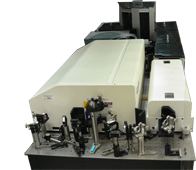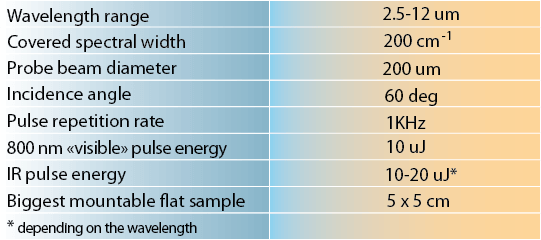Astrolabe tabletop femtosecond SFG/CARS spectrometer
Femtosecond broadband combination SFG/CARS spectrometer
Unique vibrational spectroscopy tool for monitoring surface layers in real time
Modular quick-interchangeable sample holdes for flat samples, crystals, liquid and electrochemical cells
Cost-efficient: combines two powerful nonlinear probes, specifically designed to be shared among several research groups
Compact tabletop design

1. General
Astrolabe is table-top nonlinear spectroscopy setup designed to be installed on 4×8′ (1200x2400mm) standard optical table. It consists of CPA (chirped-pulse amplification) Ti:Sapphire femtosecond laser source, femtosecond Optical Parametric Amplifier (OPA) as a source of tunable radiation, Air-spaced Fabry-Perot etalon for shaping 800nm pulses, beam delivery and conditioning system with computer-controlled delay line, gas-purged beams and sample boxes, with appropriate filters, attenuators and polarization control elements, modular sample holder and detection system consisting of spectrograph with CCD detector.
SFG spectroscopy: strengths of the method:
Specificity: probes surface layers but not the bulk of the substrate.
Sensitivity: readily detects surface concentrations less than a monolayer.
Uniqueness: optical probe with unmatched sensitivity to the surface symmetry, molecular orientation and disorder – determine the tilt of surface molecules, detect isomerisation such as kinking of molecular chains, surface disorder under pressure or due to chemical reaction, 2D phase-transitions and the like.
Reach: get to interfaces buried under layers of only partially IR-transparent material, enclosed in vacuum and liquid cells, easily relay the coherent SFG signal away from hard to reach areas without compromising sensitivity.
Where does our system stand out:
Measure FAST – acquire 1000 spectral points in the time you would otherwise measure just one point in “traditional” scanning SFG setup. This allows for real-time monitoring of surface concentrations with submonolayer sensitivity. Alternatively this provides enough time to register weak SFG signal even if the sample is short-lived.
Look WIDE: Simultaneously monitor multiple peaks and their evolution in real time over 200cm-1 frequency range; not just the amplitudes, but also bandwidths and peak shapes in general; record minutes of “vibrational spectral movie” of your process.
Time-tested tabletop Ti:Sapphire CPA system – spend time on your experiment, not on laser alignment.
Powerful IR beam capable of overcoming strong absorption and reaching interfaces covered with water, e.g. in electrochemical cell.
Powerful visible beam: split out portion of it and use it to provide a pump with SFG signal serving as a probe for pump-probe experiment with picosecond time resolution.
Unique sample positioning system with fixed base plane allowing for rapid changes of dissimilar samples and complete sample cells, all that without the need for major realignment of the optics – several research groups can share one installation reconfiguring it for new experiment in a matter of minutes.
Quickly change from vertical sample orientation (good for flat solid samples) to horizontal orientation (suitable for electrochemical cells).
Choose between copropagating IR-Visible beam geometry and on-sample crossing geometry – the former allowing for simple optical alignment; suitable for less experienced researches; use the latter if stray nonlinear optical effects has to be completely eliminated.
With minor realignment switch the system to CARS spectrometer mode, taking advantage of the same versatile sample holders and detection system. CARS, while not surface-sensitive, can complement SFG in cases where sample composition results in complicated vibrational spectra.Please read more on SFG in PDF section.
2. Specifications

3. Applications
Real time monitoring of:
Surface chemical reactions
2-D phase transitions
Surface heating and pressurization
Effects of potential changes on the electrode in electrolyte
Measurements of surface concentration (after calibration)
Pump-probe measurements of laser-induced flash heating, shock compression and chemical reactions at surfaces with picosecond time resolution (with optional high-power laser source).